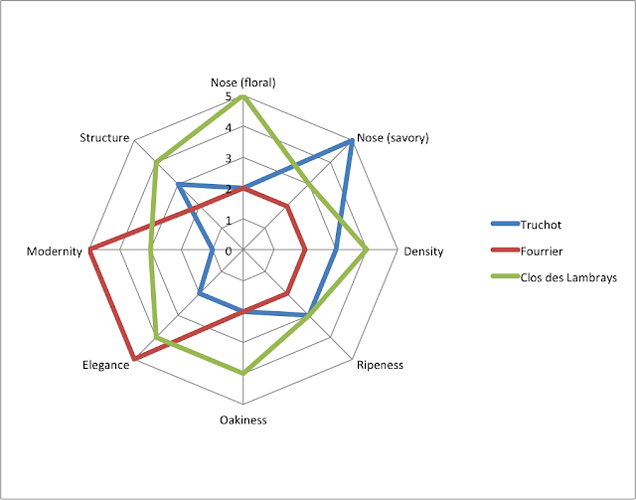Last year on Wine Berserkers, Dan Bailey started a thread called Categorising Red Burgundy Producers, and Keith Levenberg’s chart was posted a few times. I think this is really useful, but want to try to take it a step further, based on the wisdom and experience of two wine boards (Wine Berserkers and UK Wine Pages).
I am proposing to select a handful of semi-objective criteria, and then have the board burg lovers apply these criteria to various domaines and negotiants. Wisdom of the crowds meets burgundy!
As an example, I made up sample data for three popular Morey domaines (rated 1-5, with 5 being highest). When plotted, it would look something like this:
How to read the chart: Each bar in a spider chart represents one aspect of the domaine, so you can see that Fourrier and Truchot are both rated 2 on the Nose (Floral) scale, whereas Clos des Lambrays is rated 5. This profiling would allow inexperienced burg drinkers who prefer a certain style to find other wines fitting their preference. For example someone who prefers modern, elegant, less structured wines might be steered to Fourrier.
Criteria: My goal in selecting criteria is to come up with a handful of items that are semi-objective, and which might be used in describing one’s preferences. As a starting point, I propose the following criteria:
Criteria (rated 1-5, from least to most):
Nose (floral) - none (1) to floral (3) to overtly stemmy (5)
Nose (savory) - none(fruit-driven) to very savory
Ripeness - lean to very sweet fruited
Density - light to dense (think extraction or fruit intensity)
Elegance - (hard for me to define, but seems to be a popular criterion)
Modernity - rustic to polished (think barnyard to crystal clean)
Perceived Oakiness - none to dominant
Structure (when young) - attractive/easy to unpleasurable/hard
I am a little concerned that elegance might be non-objective, and hard to define what one or five are, but it seems to be a very popular descriptor. I considered adding color and acidity, but I don’t know anyone who makes buying decisions on those criteria. Transparency also seems hard to rate, and is likely a function of the other criteria.
Please note, this is sensory focused, not wine-making technique focused. As an example, while I suspect a warm maceration might add to density, I’d rather not debate this issue, and focus instead on the finished product.
Finally, I understand that different wines within each domaine taste different. This is what terroir is all about, I get it. But, I think it’s hard to deny the existence of a house style as well. If you can’t generalize, then use a nice 1er cru from the domaine’s home appellation as a reference point.
So two questions at the end of a longish post:
One: Does this seem worth pursuing? Would you find it useful or do you know others who would?
Two: Am I missing important criteria? Are any of mine redundant, or not objective enough?
If the answer to the first is sufficiently positive, then I will update the criteria based on board recommendations. Once that is done, I will begin posting domain names and requesting feedback.
Thanks for your consideration.

